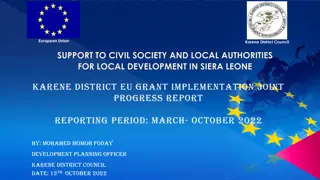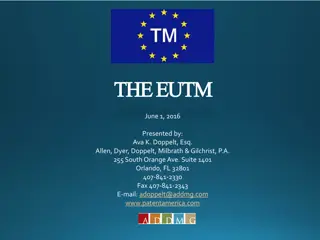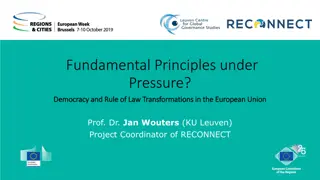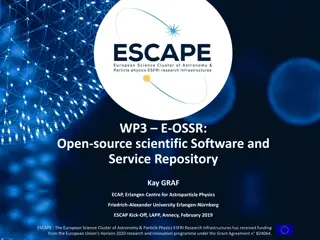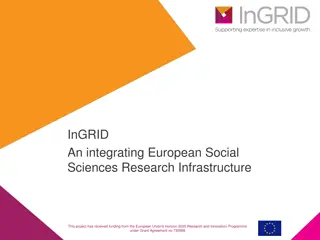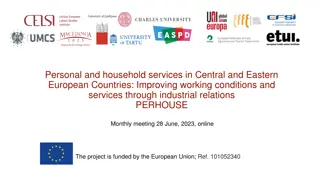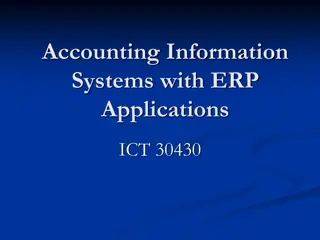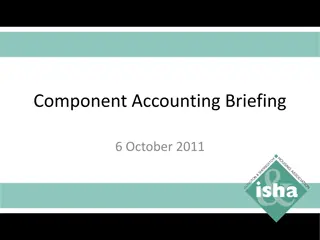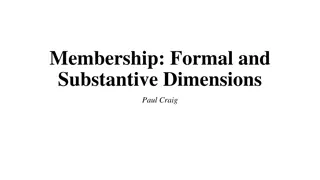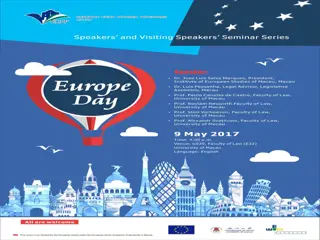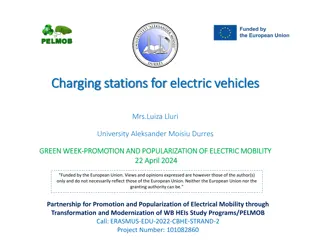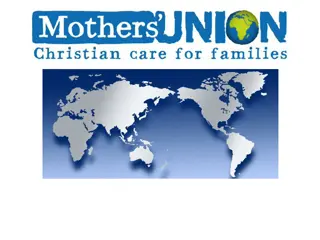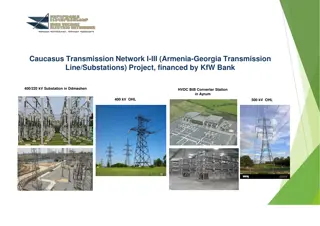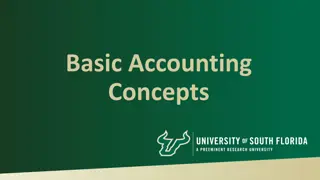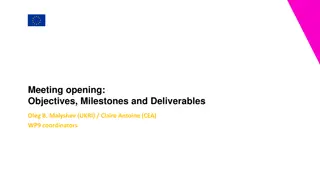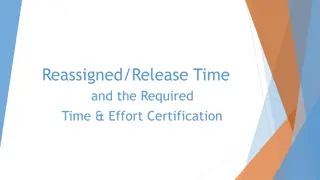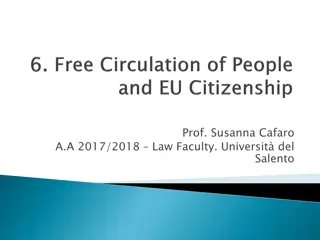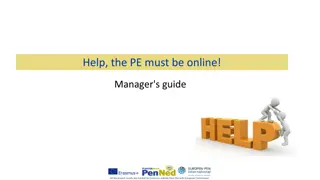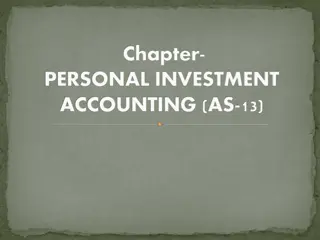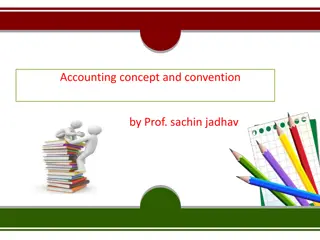Introduction to Project Management and Accounting Funded by the European Union
This presentation introduces project management and accounting principles, with a focus on planning, proposal writing, and problem definition. It highlights the importance of clear project goals, stakeholder analysis, and sustainable project outcomes. The content emphasizes the unique nature of projects, their timelines, budgets, personnel limitations, and specific organizational structures. Various planning methods, such as the Problem Tree approach, are discussed to guide project development and ensure successful implementation.
Download Presentation

Please find below an Image/Link to download the presentation.
The content on the website is provided AS IS for your information and personal use only. It may not be sold, licensed, or shared on other websites without obtaining consent from the author. Download presentation by click this link. If you encounter any issues during the download, it is possible that the publisher has removed the file from their server.
E N D
Presentation Transcript
Introduction to Project Management Introduction to Accounting Further Reading Material PROJECT MANAGEMENT The project is co-funded by the European Unions Asylum, Migration and Integration Fund. The content of this presentation represents the views of the EMVI project partnership only and is their sole responsibility. The European Commission does not accept any responsibility for use that may be made of the information it contains.
How do I develop a project? What is a project? Project Planning Method for Training: The Problem Tree Writing a Project Proposal
What is a project? According to DIN 69900*, a project is defined as an undertaking that is essentially characterised by. . . the uniqueness of the conditions in their entirety, a target, limitations of time, money, personnel or other kinds, limitations vis- -vis other projects, and a project- specific organisation. A Project has a beginning, a middle and an end. Within the framework of a project, it must be clear at the beginning where one wants to arrive at the end. The improvements as a result of a project should continue to exist even without the project (effects). o o o o Source: https://www.nord-sued- bruecken.de/foerderung/foerderprogramme/in-sdg.html *German Institute for Standardisation (DIN)
Project Planning (1) A project application reflects the planning process and is guided by the following questions: Applicant/project promoter Situation analysis Problem description Target group(s) Effects Indicators Project activities and achievements Sustainability Cost and financing/expenditure and income plan Source: https://www.nord-sued- bruecken.de/foerderung/foerderprogramme/in-sdg.html
Project Planning (2) Possible steps in the planning process (based on the Logical Framework Approach) 1. Stakeholder analysis (for more see EMVI-Module Networking 2. Problem analysis provides better insight into the existing & Advocacy) Identify individuals, groups, governmental and non- situation and the influence of the social environment on those involved; is based on the knowledge and viewpoints of those involved; is sometimes based on the creation of a problem tree, which governmental institutions, companies, etc. that may be affected by the project. The stakeholders are all related to the project affected or has emerged during participatory workshops and captures and involved, directly or indirectly, positively or negatively. maps the respective priorities of the stakeholders. A problem is a real, existing condition that is considered negative and requires change. Source: https://www.nord-sued- bruecken.de/foerderung/foerderprog ramme/in-sdg.html
Project Planning (3) Problem Definition In any case, a description of the present condition in which the target group lives is needed in order to be able to assess the future condition. Example: women and children are undernourished incomes of the farming families are low Migrants can not participate politically What is the most typical mistake in problem formulation? A common mistake in problem formulation is that the problem is expressed as a lack of a very specific solution, e.g. shortage of milk powder and medicines lack of fertilisers Export of food cash crops instead of local/self- Source: https://www.nord-sued- bruecken.de/foerderung/foerderprogramme/in-sdg.html sufficient farming
Project Planning (4) The next crucial step will be to reveal interrelationships between the problems! Example: Effect Cause Source: https://www.nord-sued- bruecken.de/foerderung/foerderprogramme/in-sdg.html
Project Planning (5) Transforming the problem into positive achievements by establishing an end/means relationship Aim /Goa l Means Source: https://www.nord-sued- bruecken.de/foerderung/foerderprogramm e/in-sdg.html
Project Planning (6) Strategic Analysis Some possible criteria The urgency of the situation Relevance for the targeted group Social aspects Existing knowledge and possibilities (in regard to the Aims at: Analysing alternative solutions that could contribute to the achievement of the objective; Evaluating the respective merits of the approaches; Selecting the best strategy based on criteria. These are targeted group) Existing financial resources and expertise etc. Complements other projects Adds to present challenges or contributes to agreed upon by the representatives of the stakeholders directly involved. decreasing inequality (e.g. gender equality) Relevant for partner countries, the EU or other international entities Source: https://www.nord-sued- bruecken.de/foerderung/foerderprogramme /in-sdg.html
Project Planning (7) Effect Analysis Main goal= Indirect effect Project goal = Direct Effect Results = Achievements Strategy for the control of fishermen's associations Market orientation strategy Source: https://www.nord-sued- bruecken.de/foerderung/foerderprogramme/in-sdg.html
Project Planning (8) Definition of Effects: Effects are changes in a state as a result of an intervention. They can be endogenous and non-endogenous, expected or unexpected, positive or negative. They occur from the first moment of the intervention, during the entire project duration and in very different areas Effects are the result of social interactions Source: https://www.nord-sued- bruecken.de/foerderung/foerderprogramme/in-sdg.html
Project Planning (9) Indicators must be SMART: Specific: specific in terms of quality and quantity; Measurable: measurable with reasonable effort; Available: available from existing source; Relevant: important for what they are supposed to measure and in Definition of Indicators Indicators ...are parameters that have been selected to illustrate a specific, often not directly measurable and complex issue ...say what a change can be observed or measured by (yardsticks) relation to the level of the project logic (type of indicator); Timely: timely, useful in a reasonable time for project management. Quantitative indicators with a performance value: XY percent of those trained have found a job Qualitative indicators with a performance value: XY say they have found a better job What information does an indicator contain? Subject reference: Who? (e.g. target group) Spatial reference: Where? (e.g. region) Time reference: When/how long? Quantity: How much/how many? Quality: How good/which criterion is changing? Source: https://www.nord-sued- bruecken.de/foerderung/foerderprogram me/in-sdg.html Example of an indicator: 100 small producers and 50 female producers in Mzuzu have increased the production of banana flour by 25% per year, achieving export quality from the 2nd year of production.
Project Planning (10) 4 ways to develop indicators: 1. measure or count: (exact numbers) Example: weigh people, give weight in kg 2. scale: (gradable description) Example: scale the frequency of diseases: always - often - sometimes - rarely - never 3. classify: (non-gradable characteristics) Example: YES or NO: "Is your child sick today?" Example: WOMAN or MAN: "Is the counselling centre run by a woman or a man?" 4. describe qualitatively: (exemplary description in words only) Example: simply describe in words what is important in the context of this indicator: "A group of women from neighbourhood X in M. have started baking doughnuts from soy flour to sell in neighbourhood Y". Source: https://www.nord-sued- bruecken.de/foerderung/foerderprogramme/in-sdg.html
Project Planning (11) Expenditure and Income plan all expenses incurred for the project must be reflected in the expenditure and income plan when applying for public funds, maximum limits must be observed (Federal Travel Expenses Act, BAk V scale of fees, prohibition of betterment, request for proposal...this needs to be nationally adopted!) Activities/Achievements All activities that must be carried out in order to achieve the project impact, i.e. the: organisational, content-related and methodological conception and design (e.g.: program schedule, speakers, main topics, questions, discussion points, methodological approach, pedagogical concept, background, special features, etc.). Cooperation and networking partners (who is involved in the Financing plan/income plan shows who finances what (applicant's own share, other donors/third-party funds, organisation to which funding is applied for). If several donors are funding a project equal cost and financing plans. Use donor CoFi forms donor harmonisation implementation of the project activities and in what form should this take place?) If it is not yet possible to make a statement on certain aspects, specify and explain further planning/decision- making. Source: https://www.nord-sued- bruecken.de/foerderung/foerderprogramme/in-sdg.html
Method for Problem Analysis: The Tree of Problems A useful tool for analysing a problem with all its causes, effects and factors visualised in the problem tree. The problem tree results from the data you collected during the needs and context analysis. 3-30 People (group work) Branches = Effects 20-4per working group Evaluation approx. 10 minutes 0 minutes Group work approx. 15-20 minutes Presentation approx. 5 minutes Introducing a tool for the problem and goal analysis Roots = Problems Flipchart paper or other large paper (A2) for group work, wide pens, tape/pens or pin board with pins. Description of the method: Ask the question: What problem are you facing in your project? Let the participants choose a problem in small groups (max. 5 persons per group) and ask them to analyse it using the problem tree method. After creating a problem tree, Source: https://www.wirkung- lernen.de/wirkung- planen/bedarfsanalyse/problembaum/ this method can be used to create a goal tree.
Method: Evaluation of Indicators Description: 3-30 People (group work) Please formulate 2-3 impact objectives and indicators for your project. Answer the following questions: - Who are our target groups? 20-40 minutes Group work approx. 15-20 minutes Presentation approx. 5 minutes per working group, Evaluation approx. 10 minutes - What problem do we want to solve for the target group? What do we want to change in the target group? - What difference do we make with our work? - Check: To what extent is your project goal SMART? Introducing a tool for the problem and goal analysis The indicators must be: SMART! Specific: specific in terms of quality and quantity; Measurable: measurable with reasonable effort; Flipchart paper or other large paper (A2) for group work, wide pens, tape/pens or pin board with pins. Availabl : available from existing source; Relevant: important for what they are supposed to measure and in relation to the level of the project logic (type of indicator); Timely: timely, useful for project management in a reasonable amount of time. Source: https://www.nord-sued- bruecken.de/foerderung/foerderprogramme/in-sdg.html, Method: Verbandsakademie f r Migrant:innenorganisationen (VAMOs) IMAP GmbH
How do I write a project proposal? What is important to know? Dos and Don'ts Further Reading Material
A good project proposal is a prerequisite for the approval of a project. However, a good project proposal does not guarantee a good project. Requirements for a good project proposal: Funding requirements are met Submitted on time In the end, it does not depend on a good project proposal and the words used in it. If the project development is well thought out, the proposal will unfold by itself... Complete application (current forms used?) All questions have been answered Does a good project Guidelines have been followed proposal equal a good The Application is clear, concise and comprehensible project? The Application is based on facts The Application logic is respected (e.g.: no description of project activities when it is about problem analysis) Source: https://www.nord-sued- bruecken.de/foerderung/foerderprogramme/in- sdg.html Cost plan reflects project activities
Dos and Donts in the writing of a project proposal Don't Do ...include essential contents, methods and didactic concepts ...assume that donors or people who decide on or include them as examples. Do so even if things are not projects know the association, the work and the always fixed and can change. concrete projects. Remember to describe your ...follow the "logical" structure of an application, without organisation and the project in a comprehensible "telling" and repeating the project idea. Be careful not to way. write about objectives and methods in the problem analysis ...put items, products or entire activities in the cost part. plan that are not even described or mentioned in ...follow the structure and do not describe the measures in the application. Especially with the sometimes epic breadth when describing the targeted group! quite useful documentation of the project, it is ...Focus on the project goal but do not make the mistake of assumed that this does not need to be explained describing too many and very different goals that are further unrealistic! Source: https://www.nord-sued- bruecken.de/foerderung/foerderprogramme/in-sdg.html
Project Management What makes a project a good project? Project Cycle Management (PCM) Aspects of Documentation and Accounting
Project Management Project One-off process Complex structure Defined goals Fixed deadline Limited costs Management Planning Management Organisation Control Planning Evaluation Monitoring Source: https://www.nord-sued- bruecken.de/foerderung/foerderprogramme/in-sdg.html
A good project: content criteria - project implementation Transparency of funding flows and project planning Monitoring and accompanying evaluation Compliance with procurement rules Personnel: recruitment/payment/gender/respect for workers' rights Flexibility: adapting project strategy if conditions change Evaluation Content criteria - Evaluation Internal evaluation External evaluation Analysis of the evaluation results Lessons learned The Basis for further projects Source: https://www.nord-sued- bruecken.de/foerderung/foerderprogramme/in-sdg.html
A good project must be good at every stage of the project cycle Project Cycle Management (PCM) Program Evaluation Identification Formation Implementation Source: https://www.nord-sued- bruecken.de/foerderung/foerderprogramme/in-sdg.html Funding/Financing
Meaningful and successful project management... .... consists of three phases/components: planning, implementation and evaluation; .... sees planning as a participatory process of shared understanding and agreement; ....focuses equally on impact and process; .... consists of defined phases; ....is open in terms of methods and tools; and ....includes cyclical feedback loops throughout the process. Source: https://www.nord-sued- bruecken.de/foerderung/foerderprogramm e/in-sdg.html
Cost items Cost plan: contains all costs including administrative costs The cost plan should reflect the measures applied for explain larger cost items in the application text Composition/amount of costs should be recognisable (if possible defined in units (e.g. 10 teaching units 90 min. 100 = 1.000,00 ) Source: https://www.nord-sued- bruecken.de/foerderung/foerderprogramme/in-sdg.html
Accounting Should be considered from the beginning! Consists of content and financial accounting Source: https://www.nord-sued- bruecken.de/foerderung/foerderprogramme/in- sdg.html
Case Report A case report should entail: 1. Situation description/problem description 2. Target groups 3. Effects/project objectives 4. Indicators (qualitative and quantitative) 5. Description and explanation of project activities 6. Cross-cutting issues 7. Sustainability 8. Cost and financing plan 9. Final evaluation (conclusion, consequences) Source: https://www.nord-sued- bruecken.de/foerderung/foerderprogramme/in-sdg.html
Everything went well. The measure was successfully implemented, and the participants were satisfied, everything worked out in terms of organisation. This is not a sufficiant case report! Source: https://www.nord-sued- bruecken.de/foerderung/foerderprogramme/in-sdg.html
Financial Report Simple/complete proof of use Consists of voucher list, cost plan, financing plan (detailed overview of all expenses and income of the project). Accounting by project/cost centre (personnel costs, fees, travel costs, accommodation/food, material costs, administrative costs) No payment without receipt Observe time limits (budget year) Check donors for economic efficiency, proportionality and plausibility Source: https://www.nord-sued- bruecken.de/foerderung/foerderprogramme/in-sdg.html
Target/Actual Comparison of Costs Last confirmed cost and financing plan in debit with reduced project costs: Administrative costs decrease in percentage terms Funding amount decreases in percentage Enclose receipts (depending on the funding agency) - Reconciliation/reference to receipts in the progress report Cost estimates must be available upon request (public procurement law: from 500 -1,000 , comprehensible price calculation with three companies, from 1,000 , Include country and regional specifics for cost comparison etc. three written offers) (Example Germany). Source: https://www.nord-sued- bruecken.de/foerderung/foerderprogramme/in- sdg.html
Receipt list Grouped by cost items (cost centres) Sorted by payment date Transfer totals of cost items to target/actual comparison Attach receipts (if possible in the same order) (for complete VN) Document fees with invoices/fee contract Proof of payment must go with the receipt Source: https://www.nord-sued- bruecken.de/foerderung/foerderprogramme/in -sdg.html
More Tips Charged costs must reflect the content of the project. Check whether all costs are eligible (travel expenses abroad) Verifiable fee scales must be taken into account (BAk V rates). Justify deviations of >20% and apply for reclassification/approval with financial statement Adjust Cofinancing in time if third-party funds are not approved Totals of cost and financing plan must match Settle accounts on time or apply for extension in time Source: https://www.nord-sued- bruecken.de/foerderung/foerderprogramme/in-sdg.html
Staff Costs Remember: Collective Bargaining Agreements Minimum wages Salary directives Include country and regional specifics for cost comparison etc. Source: https://www.nord-sued- bruecken.de/foerderung/foerderprogramme/in- sdg.html
Professional Fees Freelance services (e.g. by educational speakers, writers, scientists, artists, web designers, etc.). Basis fee contract (service rendered, exact topic, place and period). Invoice (invoice number, description of activity, Include country and regional specifics for cost comparison etc. subject, place, period) or reference to the fee contract, tax number or VAT identification number, indication of VAT or reference to VAT exemption. Observe fee scales (German BAk V) No valorised services (depending on the donor) Source: https://www.nord-sued- bruecken.de/foerderung/foerderprogram me/in-sdg.html
Administrative Costs - In case of higher costs obtain cost estimates (public procurement law). - Cost estimates (from 500 -1,000 comprehensible price determination with three companies, from 1,000 three written offers). - No "general" equipment such as cupboard, projector, PC (this can be mentioned in the project measures), but actually required things such as Accommodation/meals per participant in a specific event/project step This are country specifics of Germany as an example, replace them with your country and regional specifics Source: https://www.nord-sued- bruecken.de/foerderung/foerderprogramme/in- sdg.html
Equality Capital All funds available to the NGO (not earmarked for projects approved by other donors). (!) project- related donations are regarded as external funds by individual donors) Donations, sponsorship income, reserves from association assets Revenues from the implementation of the project generally to be used to finance the project, e.g. entrance fees, sales proceeds, participant contributions Source: https://www.nord-sued- bruecken.de/foerderung/foerderprogramme/in-sdg.html
Valorised Services Valorisation of services = valorisation of labour services without real cash flow show the value of voluntary work contributions from third parties free of charge (e.g. infrastructure such as technical equipment, meeting rooms and/or e.g. accommodation and catering) Can sometimes be counted as own resources (see funding guidelines for each country/budget line) Source: https://www.nord-sued-bruecken.de/foerderung/foerderprogramme/in-sdg.html
Decision-making processes of donors (example EU) Own contribution Own resources + income + (valorised services) = own contribution often at least 10% of total costs, some donors recognise third-party funds as own funds Third-party funds Grants from other donors (foundations, other public and private institutions) Source: https://www.nord-sued- bruecken.de/foerderung/foerderprogramme /in-sdg.html






